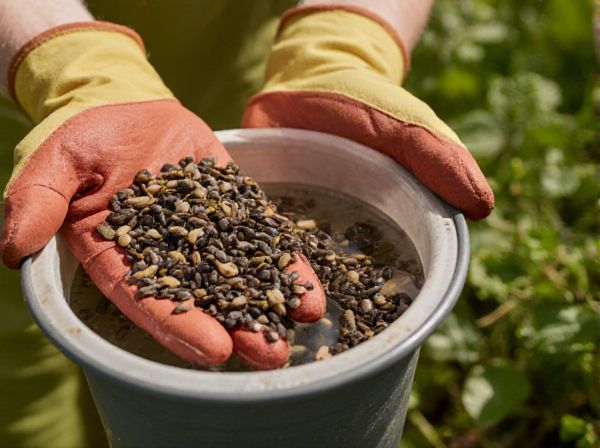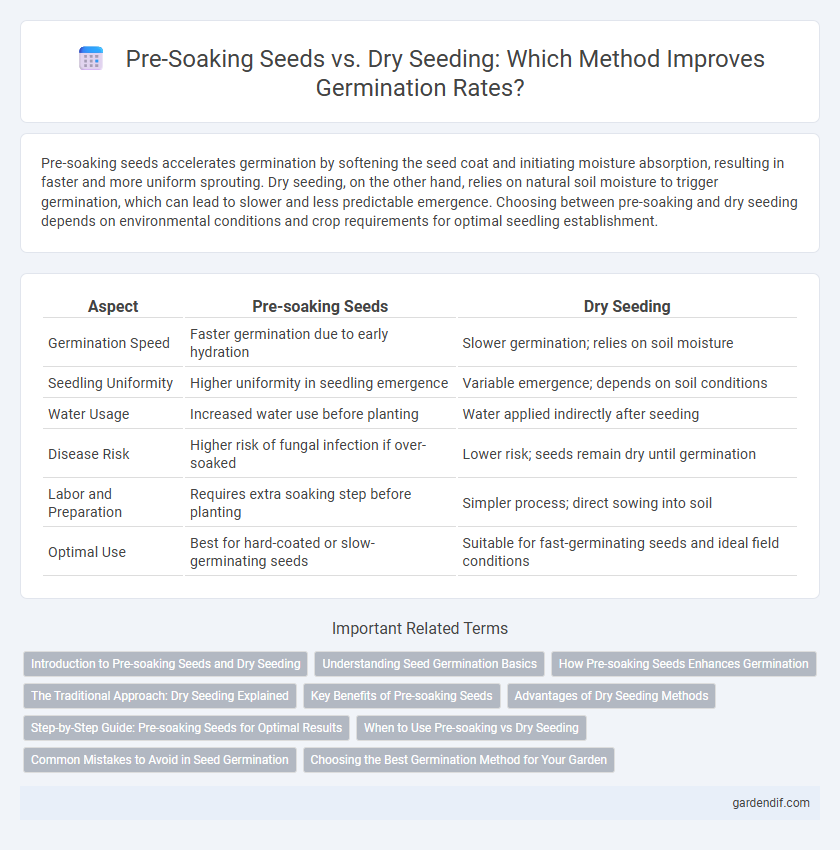
Pre-soaking Seeds vs Dry Seeding Illustration
Pre-soaking seeds accelerates germination by softening the seed coat and initiating moisture absorption, resulting in faster and more uniform sprouting. Dry seeding, on the other hand, relies on natural soil moisture to trigger germination, which can lead to slower and less predictable emergence. Choosing between pre-soaking and dry seeding depends on environmental conditions and crop requirements for optimal seedling establishment.
Table of Comparison
| Aspect | Pre-soaking Seeds | Dry Seeding |
|---|---|---|
| Germination Speed | Faster germination due to early hydration | Slower germination; relies on soil moisture |
| Seedling Uniformity | Higher uniformity in seedling emergence | Variable emergence; depends on soil conditions |
| Water Usage | Increased water use before planting | Water applied indirectly after seeding |
| Disease Risk | Higher risk of fungal infection if over-soaked | Lower risk; seeds remain dry until germination |
| Labor and Preparation | Requires extra soaking step before planting | Simpler process; direct sowing into soil |
| Optimal Use | Best for hard-coated or slow-germinating seeds | Suitable for fast-germinating seeds and ideal field conditions |
Introduction to Pre-soaking Seeds and Dry Seeding
Pre-soaking seeds involves immersing them in water for a specific period to accelerate germination by softening the seed coat and activating enzymes. Dry seeding skips this step, planting seeds directly into the soil, relying on natural moisture for germination. Pre-soaking typically results in faster sprout emergence and improved uniformity compared to dry seeding methods.
Understanding Seed Germination Basics
Pre-soaking seeds accelerates germination by hydrating the seed coat, triggering metabolic processes essential for sprouting, while dry seeding relies on natural soil moisture and environmental conditions to initiate growth. Pre-soaking enhances uniformity and speed of germination, especially in hard-coated seeds like legumes, compared to dry seeding which may result in variable emergence rates. Understanding seed moisture absorption and dormancy-breaking factors is crucial for optimizing germination success through pre-soaking or dry seeding methods.
How Pre-soaking Seeds Enhances Germination
Pre-soaking seeds accelerates water absorption, initiating enzyme activity essential for breaking dormancy and promoting faster germination compared to dry seeding. This process softens seed coats, improves oxygen uptake, and reduces germination time by ensuring seeds reach optimal moisture levels before planting. Enhanced seedling vigor and uniform emergence result from the controlled hydration environment provided during pre-soaking.
The Traditional Approach: Dry Seeding Explained
Dry seeding, a traditional approach in germination, involves sowing seeds directly into the soil without prior soaking, relying on natural moisture for activation. This method favors seeds with hard coats or those adapted to withstand dry conditions, promoting slow and steady germination. Farmers often prefer dry seeding for its simplicity, reduced labor, and lower risk of fungal infections compared to pre-soaking techniques.
Key Benefits of Pre-soaking Seeds
Pre-soaking seeds accelerates the germination process by hydrating the seed coat, which softens and stimulates enzymatic activity essential for embryo development. This method enhances uniform seedling emergence and boosts overall germination rates compared to dry seeding, especially in conditions with variable soil moisture. Improved water absorption through pre-soaking also reduces the risk of seed desiccation and increases early root growth vigor.
Advantages of Dry Seeding Methods
Dry seeding methods reduce the risk of seed rot and fungal diseases by avoiding excess moisture, making them ideal for crops sensitive to waterlogged conditions. These techniques promote better oxygen availability to seeds, enhancing root development and early vigor. Furthermore, dry seeding simplifies handling and storage logistics, increasing efficiency during planting seasons.
Step-by-Step Guide: Pre-soaking Seeds for Optimal Results
Pre-soaking seeds involves immersing them in water for 12 to 24 hours to soften the seed coat and accelerate germination by triggering enzymatic activity. After soaking, drain seeds and place them on a moist paper towel or directly into a growing medium with consistent humidity and warmth around 20-25degC (68-77degF). Monitor seed moisture and temperature closely during the germination period, typically 7 to 14 days, to ensure optimal root and shoot development before transplanting.
When to Use Pre-soaking vs Dry Seeding
Pre-soaking seeds accelerates germination, especially beneficial for species with hard seed coats or when planting in cool, dry soil to ensure faster and more uniform emergence. Dry seeding is optimal in well-prepared, warm soils where natural moisture and slow germination improve root development and reduce the risk of seed rot. Choosing between pre-soaking and dry seeding depends on seed type, soil temperature, moisture conditions, and desired germination speed.
Common Mistakes to Avoid in Seed Germination
Pre-soaking seeds accelerates germination by softening seed coats but over-soaking can cause rot or fungal infections, reducing viability. Dry seeding requires precise soil moisture and temperature control, as planting too deep or in overly dry soil leads to poor germination rates. Avoiding these common mistakes improves seedling emergence and overall crop success.
Choosing the Best Germination Method for Your Garden
Pre-soaking seeds enhances germination by softening seed coats, accelerating water absorption, and promoting uniform sprouting. Dry seeding offers simplicity and reduces the risk of seed damage or fungal infection in certain garden conditions. Selecting the best method depends on seed type, soil temperature, moisture levels, and desired germination speed for optimal plant development.
Pre-soaking Seeds vs Dry Seeding Infographic

 gardendif.com
gardendif.com